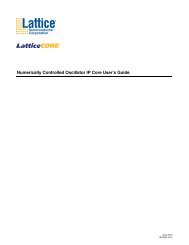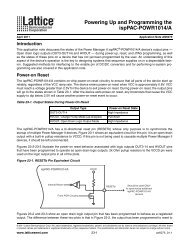DS1036 - Platform Manager Data Sheet - Lattice Semiconductor
DS1036 - Platform Manager Data Sheet - Lattice Semiconductor
DS1036 - Platform Manager Data Sheet - Lattice Semiconductor
Create successful ePaper yourself
Turn your PDF publications into a flip-book with our unique Google optimized e-Paper software.
Table 22. Power Management Section TAP Instruction Table<br />
71<br />
<strong>Platform</strong> <strong>Manager</strong> <strong>Data</strong> <strong>Sheet</strong><br />
Instruction<br />
Command<br />
Code Comments<br />
BULK_ERASE 0000 0011 Bulk erase device<br />
BYPASS 1111 1111 Bypass – Connect PTDO to PTDI<br />
DISCHARGE 0001 0100 Fast VPP discharge<br />
ERASE_DONE_BIT 0010 0100 Erases ‘Done’ bit only<br />
EXTEST 0000 0000 Bypass – Connect PTDO to PTDI<br />
IDCODE 0001 0110 Read contents of manufacturer ID code (32 bits)<br />
OUTPUTS_HIGHZ 0001 1000 Force all outputs to High-Z state, FET outputs pulled low<br />
SAMPLE/PRELOAD 00011100 Sample/Preload. Default to bypass.<br />
PROGRAM_DISABLE 0001 1110 Disable program mode<br />
PROGRAM_DONE_BIT 0010 1111 Program the Done bit<br />
PROGRAM_ENABLE 0001 0101 Enable program mode<br />
PROGRAM_SECURITY 0000 1001 Program security fuse<br />
RESET 0010 0010<br />
Reset device (refer to the RESETb signal, RESET Command Via<br />
JTAG or I2 C section of this data sheet)<br />
IN1_RESET_JTAG_BIT 0001 0010 Reset the JTAG bit associated with IN1 pin to 0<br />
IN1_SET_JTAG_BIT 0001 0011 Set the JTAG bit associated with IN1 pin to 1<br />
CFG_ADDRESS 0010 1011 Select non-CPLD address register<br />
CFG_DATA_SHIFT 0010 1101 Non-CPLD data shift<br />
CFG_ERASE 0010 1001 Erase just the non-CPLD configuration<br />
CFG_PROGRAM 0010 1110 Non-CPLD program<br />
CFG_VERIFY 0010 1000 Verify non-CPLD fuse map data<br />
CPLD_ADDRESS_SHIFT 0000 0001 CPLD_Address register (169 bits)<br />
CPLD_DATA_SHIFT 0000 0010 CPLD_<strong>Data</strong> register (243 bits)<br />
CPLD_INIT_ADDR_FOR_PROG_INCR 0010 0001 Initialize the address register for auto increment<br />
CPLD_PROG_INCR 0010 0111 Program column register to E2CMOS and auto increment address<br />
register<br />
CPLD_PROGRAM 0000 0111 Program CPLD data register to E 2 CMOS<br />
CPLD_VERIFY 0000 1010 Verify CPLD column data<br />
CPLD_VERIFY_INCR 0010 1010<br />
Load column register from ECMOS2 and auto increment address register<br />
UES_PROGRAM 0001 1010 Program UES bits into E2CMOS UES_READ 0001 0111 Read contents of UES register from E2CMOS (32 bits)<br />
BYPASS is one of the three required instructions. It selects the Bypass Register to be connected between PTDI<br />
and PTDO and allows serial data to be transferred through the device without affecting the operation of the <strong>Platform</strong><br />
<strong>Manager</strong>. The IEEE 1149.1 standard defines the bit code of this instruction to be all ones (11111111).<br />
The required SAMPLE/PRELOAD instruction dictates the Boundary-Scan Register be connected between PTDI<br />
and PTDO. The <strong>Platform</strong> <strong>Manager</strong> has no boundary scan register, so for compatibility it defaults to the BYPASS<br />
mode whenever this instruction is received. The bit code for this instruction is defined by <strong>Lattice</strong> as shown in<br />
Table 22.<br />
The EXTEST (external test) instruction is required and would normally place the device into an external boundary<br />
test mode while also enabling the boundary scan register to be connected between PTDI and PTDO. Again, since<br />
the <strong>Platform</strong> <strong>Manager</strong> has no boundary scan logic, the device is put in the BYPASS mode to ensure specification<br />
compatibility. The bit code of this instruction is defined by the 1149.1 standard to be all zeros (00000000).









